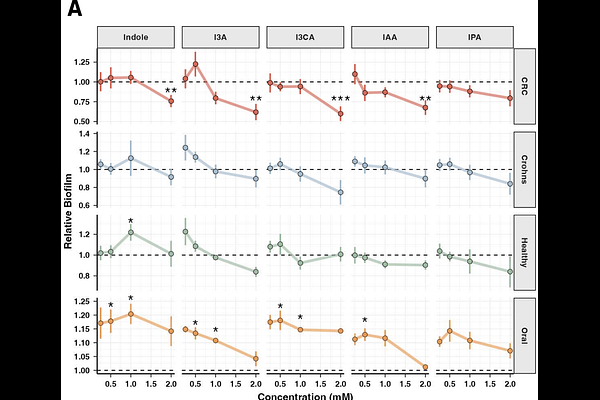Comparative Analysis of Indole Derivative Production Among Clinical Isolates of Fusobacterium nucleatum

Comparative Analysis of Indole Derivative Production Among Clinical Isolates of Fusobacterium nucleatum
Scano, C. J.; Choudhury, A.; Greathouse, L.; Rojo, M.; Lavado, R.; Zaharas, G.; Hawkins, J.
AbstractObjectives: To investigate how indole production modulates Fusobacterium nucleatum virulence across different disease states. Methods: Total indole production was measured in 16 F. nucleatum isolates (CRC: n=6, Crohn\'s: n=6, healthy: n=3, oral: n=1) using Kovac\'s reagent. Disease-associated indole derivatives-indole, indole-3-acetic acid (IAA), indole-3-aldehyde (I3A), indole-3-carboxaldehyde (I3CA), and indole-3-propionic acid (IPA)-were quantified via HPLC. Isolates were treated with exogenous derivatives to assess impacts on biofilm formation and virulence gene expression. A naive Bayes classifier trained on virulence factor data evaluated niche-specific responses. Results: CRC isolates produced significantly more total indole than healthy isolates (p<0.05). Indole derivatives minimally affected non-CRC isolate growth but reduced CRC isolate carrying capacity. Total indole positively correlated with biofilm formation in CRC isolates (R2=0.50-0.70; p<0.001). Crohn\'s isolates formed most biofilm but were unresponsive to indoles; CRC isolates showed reduced formation. A Naive Bayes classifier accurately predicted disease association from indole-induced virulence factor expression (AUC=0.90-0.92, Accuracy=0.74-0.75; p<2e-16). Conclusions: CRC-associated isolates show unique metabolic profiles with elevated indole production and respond distinctively to indole exposure, suggesting potential therapeutic targets.